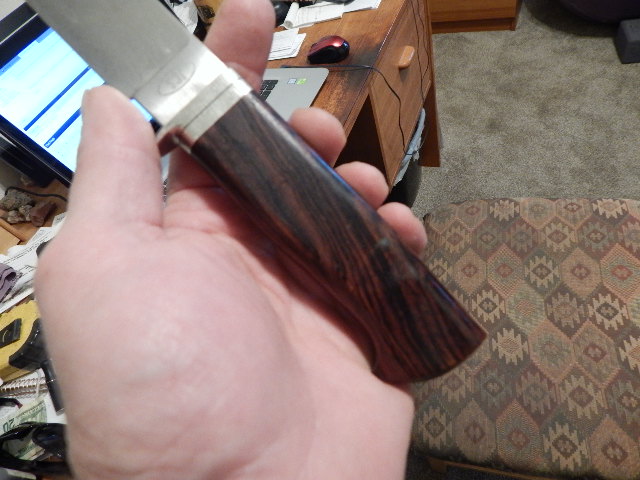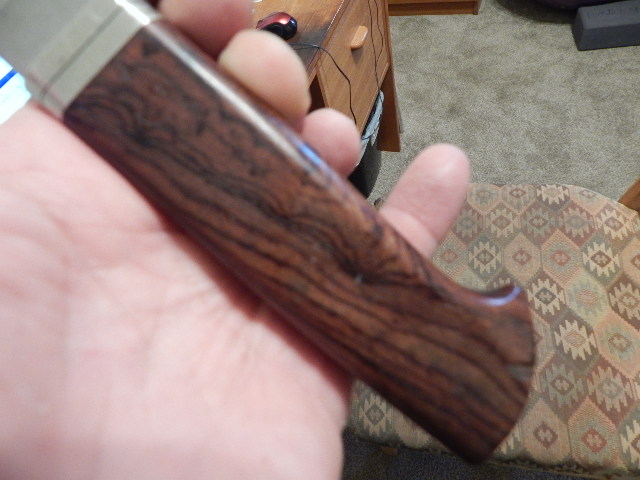Hey guys,
I'm working on a chef's knife for a customer and they have requested natural materials. I'm a little worried about having a non synthetic handle on a knife that's going to get used and washed (by hand). Do you put any sort of oil over it or finishing cover? The wood is cocoboa. Wondering if I can come straight off of the buffing wheel with it since it won't be stained.
Thanks in advance,
Travis<><
Cocobolo is a poor choice for food type cutlery, mainly because some people are allergic to it, and some are Severely allergic to it. I fall into the second range of people....although for me, I can handle it safely, but the dust will put me in the hospital (if I breath it in)
Cocobolo is so dense and oily, it will not accept any type of finish. The best you can do is wax it down well, and hope for the best. I don't know how much of it you've used in the past, but with exposure to UV light, and the "wet/dry" cycles of hand washing will quickly turn the wood a dull "poop" brown color. In the past I have had clients who wanted to return the knife because of the handle "changing colors"..... and the only option you have as the knifemaker is to replace the handle/scales. Not a good cycle to get into.
Also, unless you know the person the knife is going to.... and I mean know them personally, DO NOT take their word that the knife will not go into the dishwasher. Time and experience has taught me to be very picky about whom I build any kitchen/food type cutlery for. Because of all the dumb things people did to them early in my career, that caused me grief beyond measure.
When I build one now, there are a couple pages of "dos" and "don't" that go along with the knife, specifically stating that if the customers does "XXXXX" to/with the knife, the warranty is void. Most won't even read it, but when they call you, telling you that their knife handle is wrecked because "somebody" put it in the dishwasher..... you're not on the hook for someone else's case of the stupids.
Ed Caffrey, ABS MS
"The Montana Bladesmith"
www.CaffreyKnives.net
I'm putting myself in your shoes.
I would have a couple of concerns. First, being sure the customer knows that natural handle materials is just one reason that the knife must not be put in a dishwasher. Second, the wood often causes allergic reactions when ground but I would have reservations using it for a food prep knife.
When someone has a custom knife that's carbon steel and natural handle materials, they are accepting the responsibility for it's care and anything else that might arise from their choice of materials. But I think the discussion should be had in fairness to them.
I personally would have no problem caring for such a knife or using it. I would wax/oil the handle and hand wash and oil it after use.
I like cocobolo but I can only use it intermittently. If I make two knives in a row or spend time in the dust, I break out in hives.
I think this would depend on your customer's experience and maintenance habits. Some outdoor guys can keep a carbon steel hunter blade in pretty good shape, while others should really own a stainless blade. I have found that this is the same with kitchen cutlery, but to a much more obsessive level. No quality knife should EVER be put in a dishwasher, even if it has synthetic handle materials. If your customer is the type to cut up some chicken that then toss the knife into a sink full of forks and spoons, then do whatever you can to talk him out of the wood. But if he is experienced in the kitchen and knows how to maintain a good knife, then a handle made from a member of the dalbergia (rosewood) family would be a very pleasant addition to his kitchen.
I have a damascus chef’s knife with a camatillo handle that looks as good as the day I hung it over my cutting board, and I am a little bit of a slob in the kitchen. All I had to do was train myself to hand wash it immediately after use, dry it and oil the blade. I am not sure I would have the same luck with another family of wood. But the dalbergias, e.g. blackwood, cocobolo, rosewood etc., are all very oily and dense and require no coating in the finish. To be honest, if the customer couldn’t maintain a handle made from one of these woods, I also would discourage him from carbon steel as that will go south even quicker. A $1000 handmade kitchen knife is very much worth it, if the customer is also on that level in the kitchen. It is a very fine-tuned tool, perhaps at the pinnacle of fine-tuned knife performance. If the customer doesn’t have some cutting board skills, and maintenance discipline, it will be an overpriced disappointment to them. On the other hand most of the population enjoy plastic handled stainless steel blades, due to what they do with them.
Ed mentioned a couple of things that your customer should consider, however. Cocobolo is toxic to a significant portion of the population. I get burning nose and eyes, and a bit of an itchy sensation on my skin when I am exposed to the dust. Some people could be sensitive enough to react to touching the wood. But, as Ed mentioned, the color of this wood is not as stable as others and this is why I use it less that other woods. In a few months, that rich red color, and contrasting grain, will all be a dark brown to black as it oxidizes. I have found that this is more a matter of exposure to light than to the air. Dish soaps, like Dawn, are designed to take away oils… well, remember what makes these rosewoods finish so naturally? Even hand washing with a detergent like this will eventually take the oils off the surface and give it a dull, lackluster, or even crappy looking finish. At my sink, right next to the Dawn, is liquid antibacterial hand soap, and I got to get that chicken slime off my hands anyhow. So, I just wash, and dry, both at the same time.
Tung oil, left to dry will fill some of the pores on these woods, but another finish I have used is to melt a bit of beeswax in lemon oil until it makes a paste, and then apply this to the wood and buff it in.
"One test is worth 1000 'expert' opinions" Riehle Testing Machines Co.
Here's one of my first ten I gave to a friend (well I guess we can still be friends) it's about 5 years old. The knife is AEB-L with a Cocobolo handle and a micarta bolster this is after "it might have gone through the dish washer a couple times". It turned pretty black. I think I used Tru oil back then now it would be tung oil if anything,though this happened I still like rosewoods,but I do not use cocobolo anymore.

Wow. Thank you all for the great information. Sounds like Cocobolo is a bad choice. The steel on this blade is stainless to try and take the maintenance side of it down. The customer is adamant that it is a wood handle, but they left the choice of wood up to me. This would be my first time working with cocobolo. This is only my 7th knife, first stainless, so I'm pretty limited in experience with most of this. I will try to find some Rosewood and go that route. I do know the customer personally, but it does sound wise to include a do's and don'ts list when shipping the knife.
Thanks all for your advice!
Travis<><
What about stabilized natural wood? There are a ton on good looking stabilized wood blocks and scales on the market.
|quoted:
What about stabilized natural wood? There are a ton on good looking stabilized wood blocks and scales on the market.
I don't know Scott. It makes sense that stabilized could hold up better to being hand washed. Any thoughts on this?
Travis<><
I think a stabilized wood is a better choice in general for a kitchen knife that you will be selling. Walnut is another good choice if you want something fairly homogenous in color and with good wear resistance. Cocobolo gets a lot of bad press and it's easy to see why. I still love that wood, but it does make me sneeze and congested every time I sand it.
I still have the first knife I ever made (in 2005!) and carry it on every hike, every hunt, virtually every time I go into the field, this knife has been on my hip.
It has a cocobolo handle and I cannot tell you how many times this has been covered in mud, blood, guts, rain, and what have you. I just pulled it out of the desk drawer and wiped the handle off with a damp paper towel. I might wax this once a year.
Joshua States
www.dosgatosforge.com
https://www.youtube.com/channel/UCdJMFMqnbLYqv965xd64vYg
https://www.facebook.com/dos.gatos.71
Also on Instagram and Facebook as J.States Bladesmith
“So I'm lightin' out for the territory, ahead of the scared and the weak and the mean spirited, because Aunt Sally is fixin’ to adopt me and civilize me, and I can't stand it. I've been there before.â€



